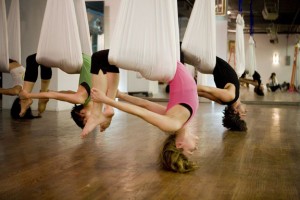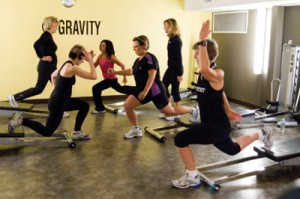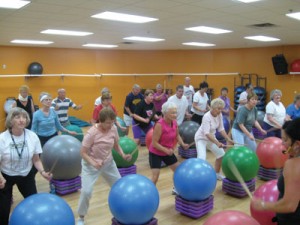
Group X has the ability to push members greater than almost anything else the club can provide. With the large amounts of influence from peer members and instructors, people will be more inclined to spend more time in the club and spend more money. The hardest aspect will be to figure out how it can work in your club.
Group X is constantly changing. Aside from different variations on already popular classes, many Group X classes find themselves constantly evolving. For example, Canton Club located in Baltimore, Md. decided to institute a new spin on the ever-growing popularity of yoga.
“Canton contacted me to bring anti-gravity yoga to Baltimore,” said Cecelia Bellomo, the air yoga instructor at Canton Club. “It’s a cross between yoga and Cirque du Soleil. One student said she had never stretched as much with air yoga.”
Aside from Canton Club, other clubs throughout the U.S. have launched air yoga platforms as a response to new group fitness classes. Crunch has embraced the yoga that uses flowing fabric hammocks suspended from the ceiling, among many other classes, such as BodyWeb that uses the TRX System Ropes and Surfboarding that uses Indoboards.
Some clubs like Heavens Fitness Club in Calgary, AB, have launched group fitness classes with the long-time concept of the Total Gym, being referred to as GRAVITY. “We offer GRAVITYGroup, GRAVITYPersonal Training and GRAVITYPilates classes,” said Helen Vanderburg, the owner of Heavens Fitness. “GRAVITY has a wide appeal in our facility as it meets the needs of diverse members. GRAVITYGroup has brought a lot of people to group strength classes that may not otherwise attend a group class.”
GRAVITY gives members a group class that uses a piece of equipment that has become comforting through decades of TV commercials. Instructors pump up music and get greater results than the home version due to the continuous push from the Group X trainer.
GRAVITY has been part of a movement taking strength training into the Group X classes. Also, once found only in personal training, Kettle Bells are making their way into the Group X category.
Kettle Bell equipment typically hasn’t been used in Group X classes; however, many clubs have transferred it from personal training and gained results through Group X. They key has been the members that are looking for the same type of results they could possibly receive when taking on a personal trainer without the additional cost. Yes, this could be perceived to pull members away from personal trainers, but in reality it will give members a better chance to see what PT can do for them.
When Kettle Bell workouts are incorporated into Group X classrooms, the perceived value behind the club becomes much greater. “Each club has its own personality,” Maks said. “While one club may love bootcamps, Bodypump and Pilates, another club may want more step, kickboxing or yoga. I listen to member feedback about the classes — what the members’ likes and dislikes are.” By listening to the club members, owners have the ability to stay on top of what Group X classes should be implemented.
“Group fitness instructors need fresh tools and Kettle Bells allow the instructor to be non-traditional and bring something new to the class,” explained Myrna Brady, the director of marketing for KettleBell Concepts. “Not every club member can use personal training or push themselves to get the results they want. But, group fitness classes create a community; it becomes a key component to members’ attentions and can play an integral roll in retention.”
Great marketing is the key to any successful product or the implementation of additions to a business. However, since new Group X classes have emerged and clubs have seen themselves offering more than just traditional aerobic classes, marketing has become everything.
Certain new classes like Zumba have already developed marketing schemes to help clubs get information to their members. “In an era of discerning consumers and ubiquitous social media, there is nothing more powerful than word of mouth,” explained Jeffrey Perlman, the vice president of marketing for Zumba.
Perlman said the biggest assistance to modern clubs has been social networking. Clubs are able to launch new Group X classes and release the schedule in many different areas — websites, Facebook and Twitter. Not to mention, many clubs have the ability to harness e-mail addresses to reach out to members.
“By doing this, Group X participants start talking to each other and then start talking to the world,” Perlman said. “Picking up and harnessing conversation. If there is a lot of buzz around one class, don’t change the class; don’t change the time, don’t change the instructor and certainly don’t change the name.”
Crunch Fitness, a club that has become recognized for its large assortment of Group X classes, has embraced technology to drive new and inventive classes. “Crunch markets our programming mainly through our website,” explained Donna Cyrus, the senior vice president of programming for Crunch Fitness. “Not only do we highlight our newest classes, but we even show video of the workout. This gives our members and prospective members a snapshot of what to expect when they come to the class.”
By visually introducing members to the class, they lose their apprehensions about taking the class. Also, members are more likely to spend more time on the club’s website when they can watch video. Maybe they can’t make the class that week, but they can still surf for new classes the club may offer. By showing them video concepts of the class, they are more likely to sit and browse classes for longer and be more prepared when the class begins.
Technology in Group X
It’s undeniable that Group X has changed over the years, and that technology has found its way into classes. “There has been a seismic shift in the fitness industry toward convenience and flexibility of our product for the customer,” said David Kraai, the principal for Fitness on Request. His company creates an interactive-video product that instructs Group X classes. “The world we live in is increasingly focused on efficiency and availability — we certainly have seen a demand for more flexible scheduling from customers with less traditional work hours.”
Members have a desire to use Group X whenever they want. With Fitness on Request, and other technology-based products, members have that freedom. “Clubs can make their group fitness classes available whenever their members are able to take the classes,” Kraai said. “It can help take pressure off the heavily attended classes by offering flexible versions of those classes at off-peak hours.”
Building Profits with Group X
Traditionally, Group X has been incorporated in to the monthly club fee. However, in recent years clubs have found a way to spin certain Group X classes so that they can enhance the club’s bottom line. Classes such as Pilates and others give the same feel as a yoga class, but can be charged to the members.
“By offering the full range of Pilates equipment, a new style of group class has recently taken off,” explained Lindsay Merrithew, the president and CEO of STOTT PILATES®. “Often referred to as ‘Pilates Circuit Training,’ a class navigates through the entire studio using all equipment options available to them.” By utilizing Pilates as a profit center, the club can offer Pilates equipment without breaking the bank.
Clubs must think outside the box when it comes to Group X in order to turn the sector into a profit center. Clubs don’t typically charge for spinning classes. However, most clubs have stationary bikes that simulate pedaling in various stances. Cycling classes with RealRyder give members more of an actual bike simulation. Clubs have an opportunity to tap into the cycling community and charge for more realistic classes the cyclists may need during the cooler months. “A perfect example of building a profit center is represented by small group and traditional larger group training,” said Douglas Brooks, M.S., a leading exercise physiologist, international fitness industry presenter and director of education at RealRyder International. “Both member and club/studio can benefit.”
These concepts aren’t traditional for the club. They require owners to look at the big picture and discover new marketing techniques to hit new populations. However, when the club taps into a few members of a demographic, they will help spread the word.
Look at making Group X classes non-traditional, affordable and in good time slots and members will respond. These types of classes will take time, but they have the ability to completely redefine the club experience. -CS











